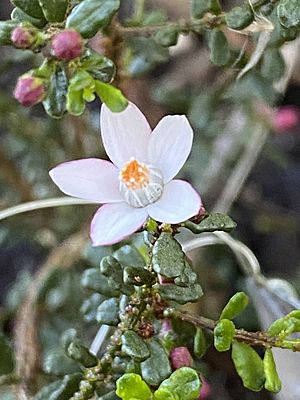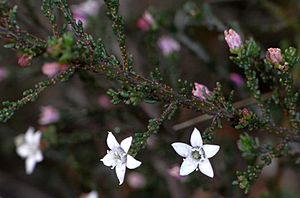Narrow-leaf wax flower facts for kids
Quick facts for kids Narrow-leaf wax-flower |
|
|---|---|
 |
|
| Philotheca angustifolia subsp. montana in the ANBG | |
| Scientific classification | |
| Genus: |
Philotheca
|
| Species: |
angustifolia
|
| Synonyms | |
|
|
The Narrow-leaf wax-flower (Philotheca angustifolia) is a beautiful flowering plant. It belongs to the family Rutaceae, which also includes citrus fruits like oranges! This plant is special because it is found only in south-eastern Australia. This means it is endemic to that area. It grows as a shrub with small leaves. In spring, it shows off lovely white flowers with five petals that look a bit like eggs.
What Does It Look Like?
The Narrow-leaf wax-flower is a shrub that can grow from about 0.3 to 2 meters tall. Its stems have small, bumpy spots called glands. You might also see a few tiny hairs in the grooves where the leaves meet the stem.
Its leaves are small, usually shaped like a cylinder or a club. Some can even be egg-shaped. They are attached directly to the stem without a stalk. These leaves are also covered in those warty glands. They are typically 2 to 10 millimeters long and 1 to 2 millimeters wide.
The flowers grow either one by one or in small groups of up to four. They appear at the ends of the branches. Each flower sits on a tiny stalk called a pedicel, which is about 0.5 to 4 millimeters long.
Each flower has five small, triangular sepals (these are like tiny leaves that protect the bud). They are about 1 millimeter long. The five petals are white and egg-shaped, usually with a pink line down the middle. They are 5 to 8 millimeters long. Inside the flower, there are ten stamens, which are the parts that make pollen. Each stamen has a small white tip called an anther, and a tiny white extra piece on it.
How It Was Named
The Narrow-leaf wax-flower was first officially described in 1970. A scientist named Paul Wilson gave it the name Eriostemon angustifolius. He published his description in a science journal called Nuytsia. The first plant used for this description, called the type specimen, was collected in the lower Mount Lofty Ranges by Darrell Kraehenbuehl.
Later, in 1998, Paul Wilson moved the species to a different group of plants, the genus Philotheca. So, its new name became Philotheca angustifolia.
In 1970, Wilson also described two slightly different types of this plant, called subspecies. These were subspecies angustifolius and subspecies montanus. These subspecies were also moved to the Philotheca group. The Australian Plant Census has accepted these names:
- Philotheca angustifolia subsp. angustifolia: This type has leaves that are cylindrical or club-shaped. They are 2 to 10 millimeters long and less than 1 millimeter wide.
- Philotheca angustifolia subsp. montana: This type has egg-shaped leaves. The narrower end is towards the base. These leaves are about 4 millimeters long and 2 millimeters wide.
Where It Lives
The Narrow-leaf wax-flower grows in open woodlands and areas with mallee plants. Mallee is a type of Australian bushland where many eucalyptus trees grow as multi-stemmed shrubs.
The subspecies angustifolia is found in central Victoria and in south-eastern South Australia. There is also one old record from 1882 in southern New South Wales. The subspecies montana is only found in the mountains of western Victoria.


